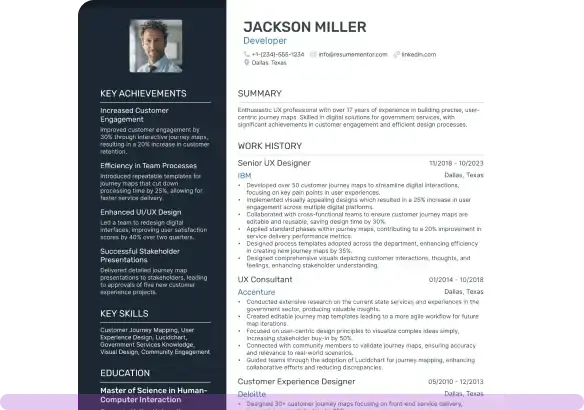Trainer Resume Examples

Mar 26, 2025
|
12 min read
Craft a winning trainer resume that showcases your skills and experience, positioning you as the ultimate "fit" for the role. With this guide, learn how to "train" your resume to stand out and gain interviews.
Rated by 348 people
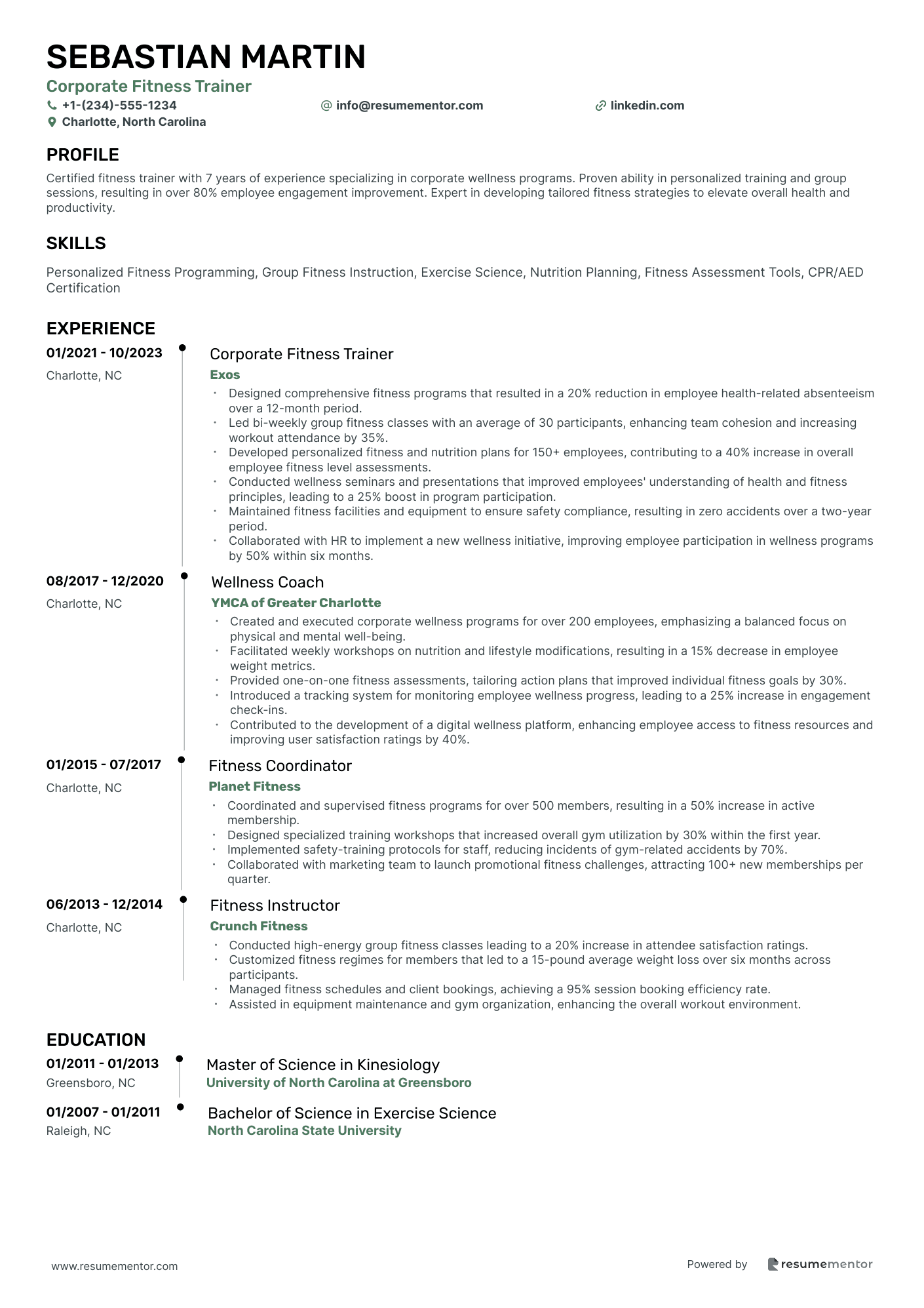
Corporate Fitness Trainer

Software Skills Trainer
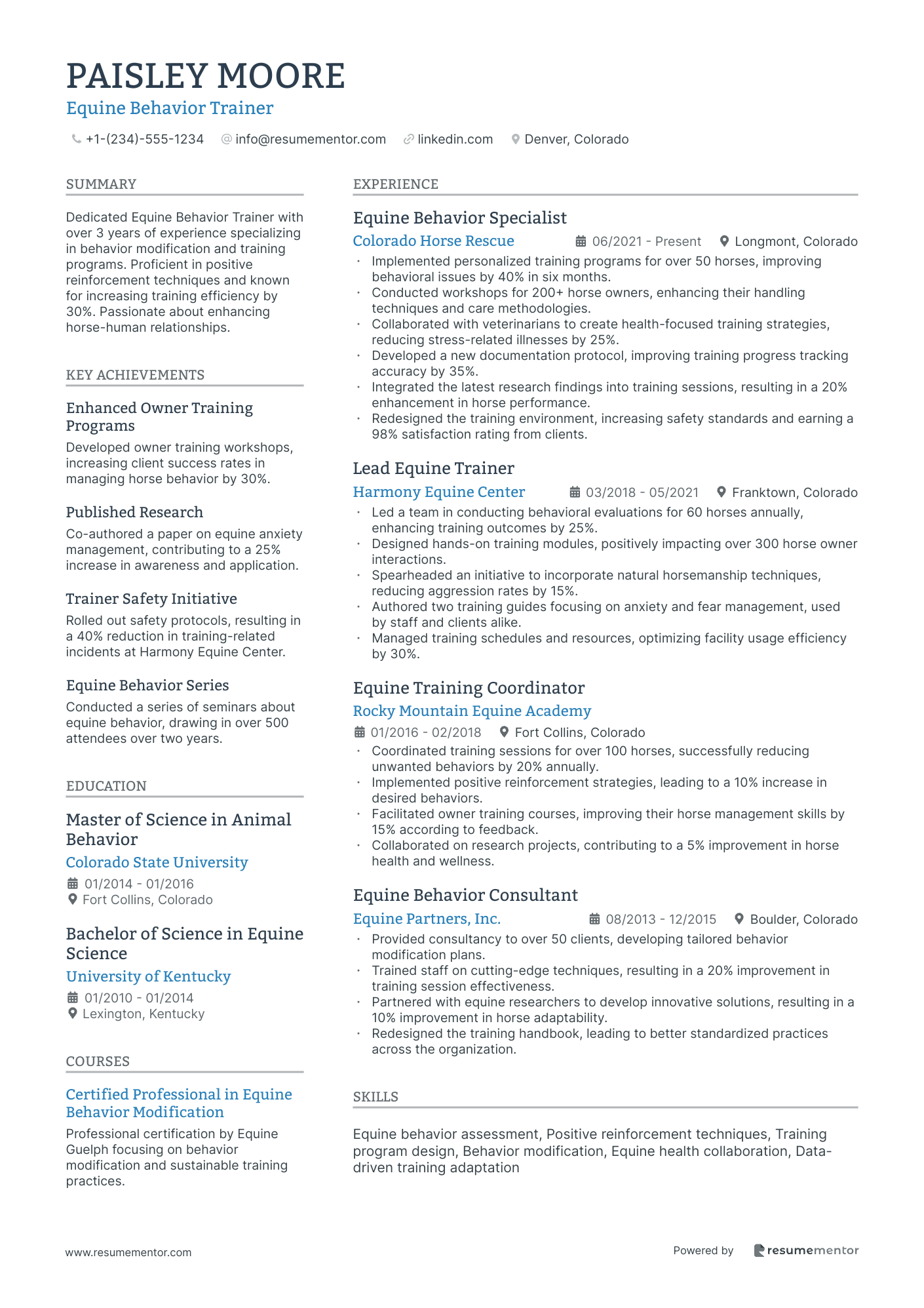
Equine Behavior Trainer
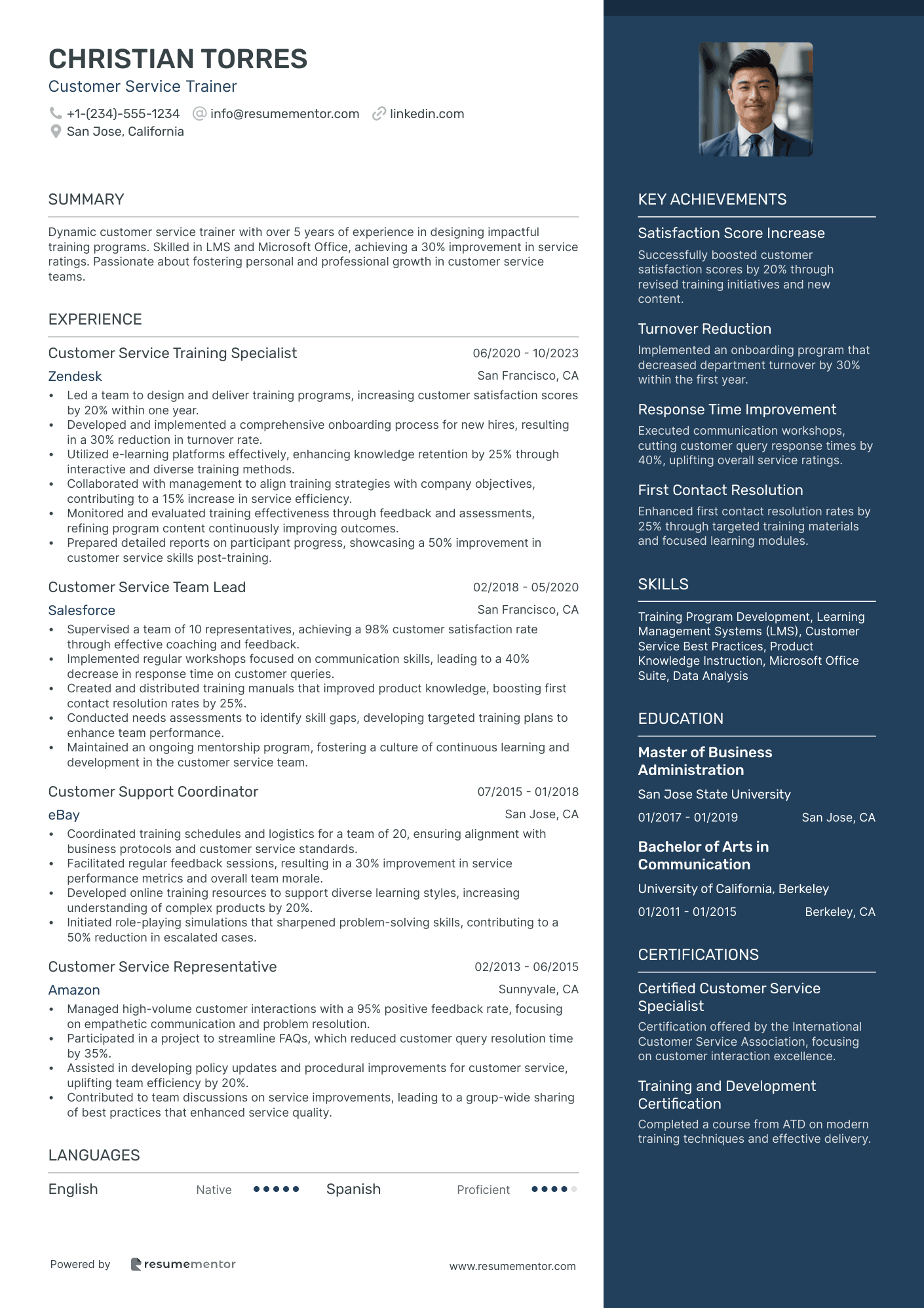
Customer Service Trainer
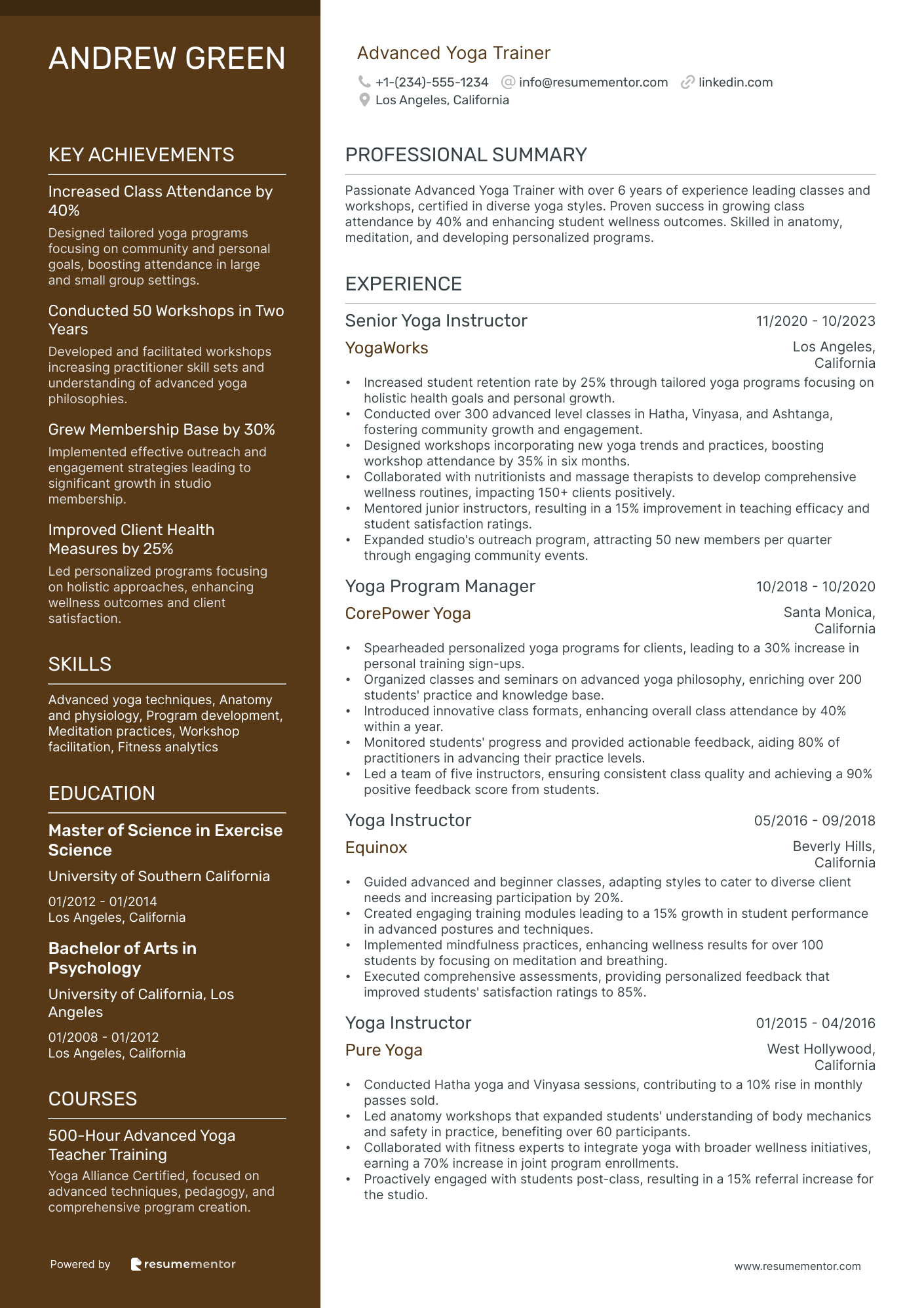
Advanced Yoga Trainer
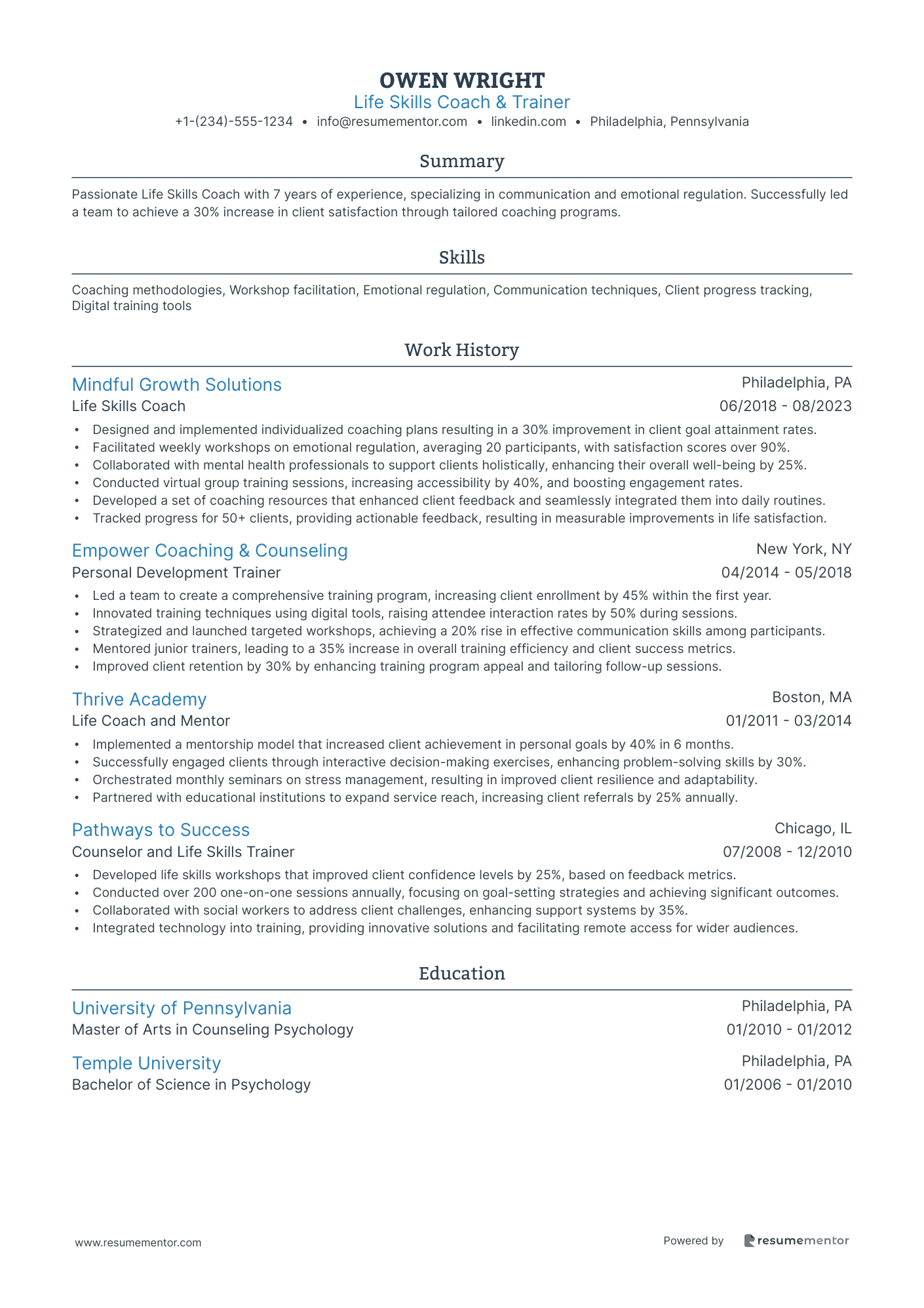
Life Skills Coach & Trainer
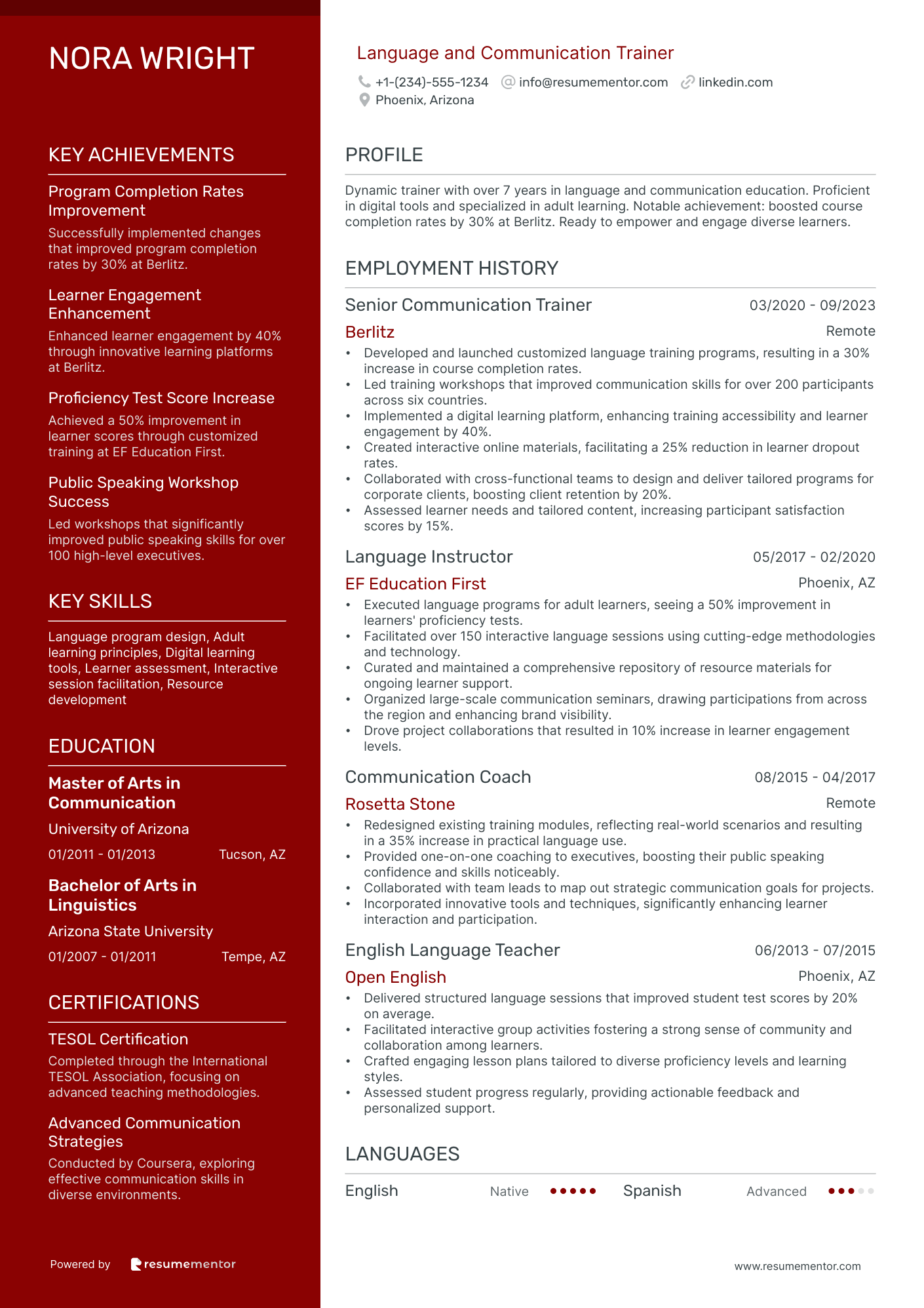
Language and Communication Trainer
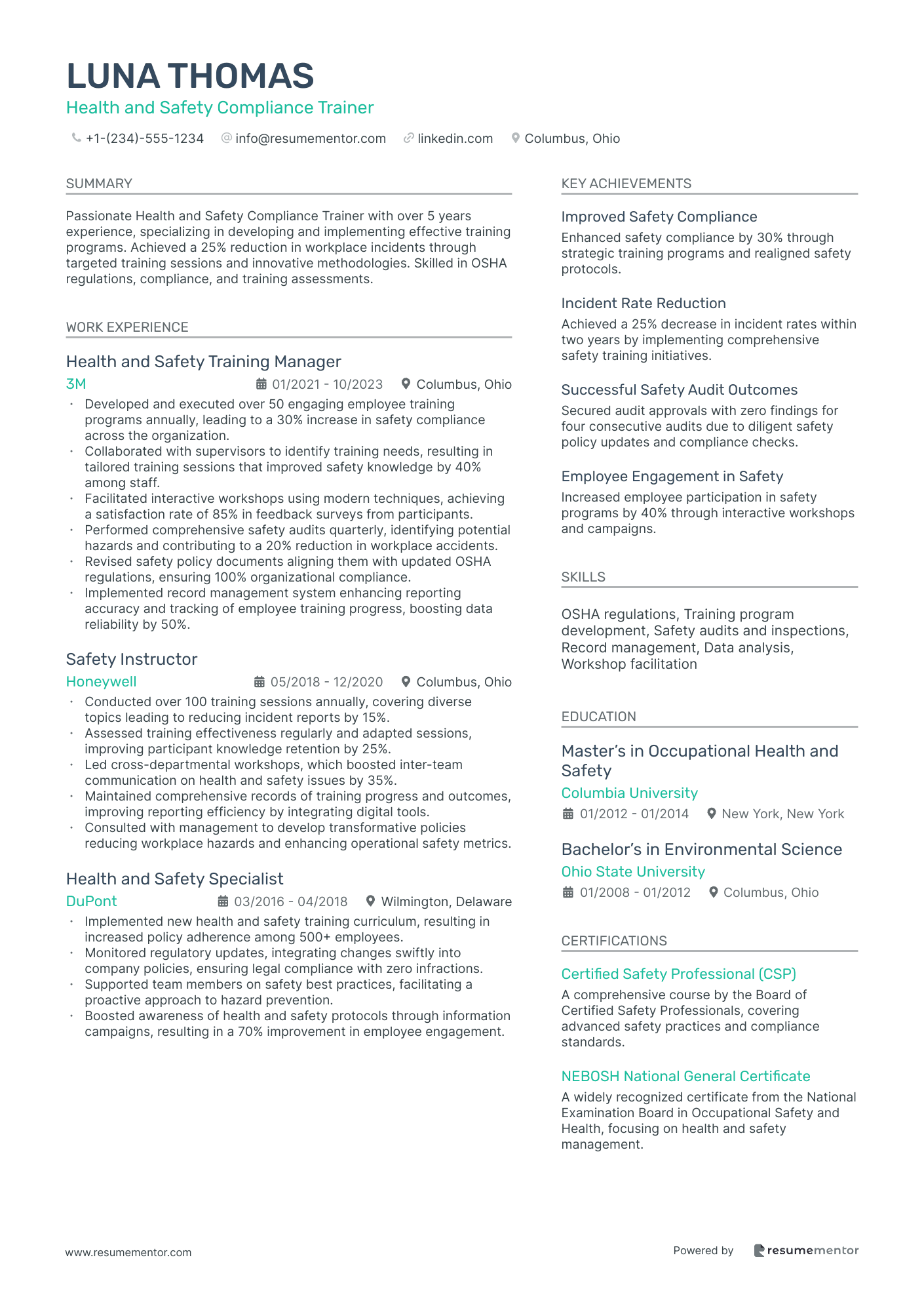
Health and Safety Compliance Trainer
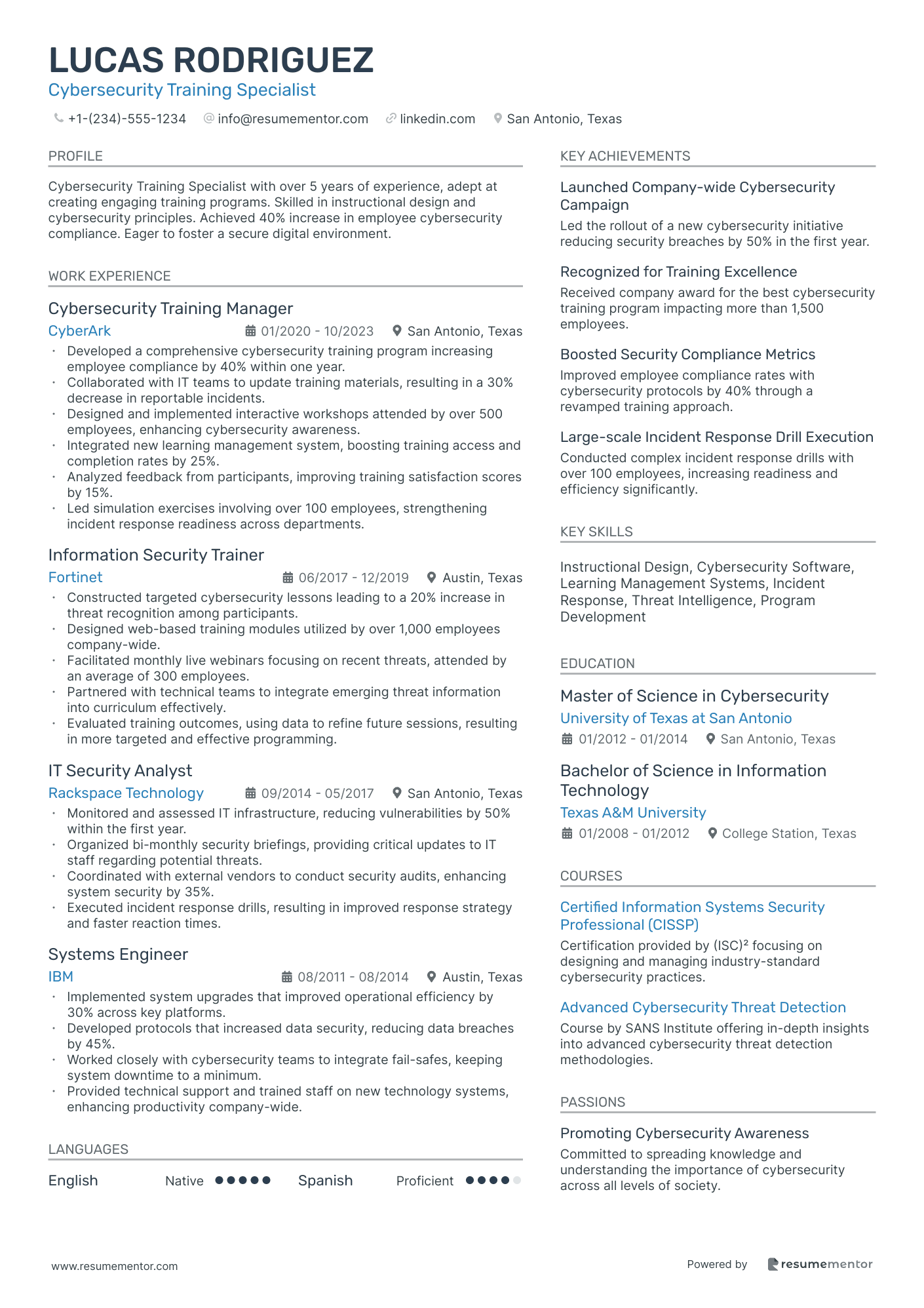
Cybersecurity Training Specialist
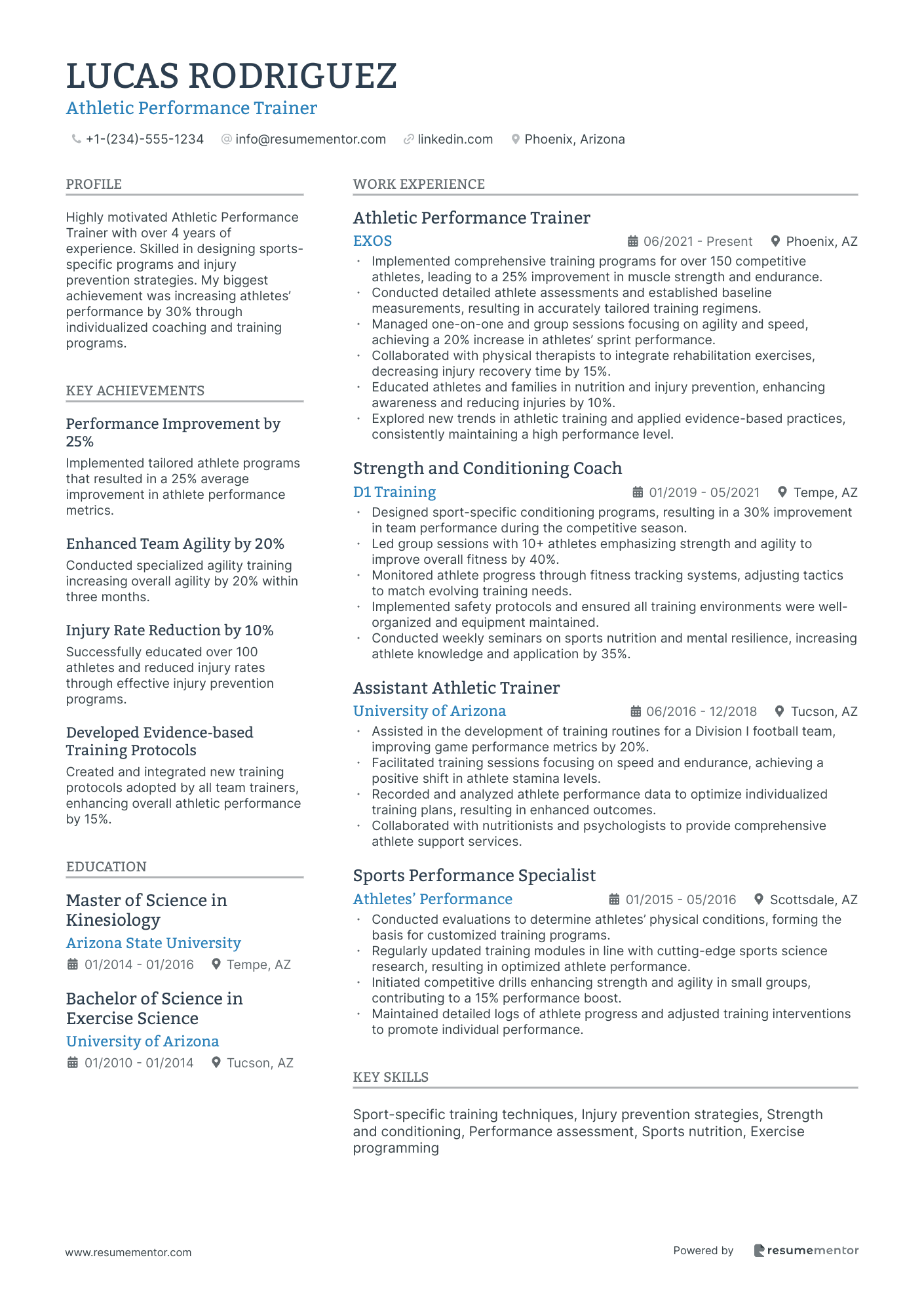
Athletic Performance Trainer

Corporate Fitness Trainer resume sample
- •Designed comprehensive fitness programs that resulted in a 20% reduction in employee health-related absenteeism over a 12-month period.
- •Led bi-weekly group fitness classes with an average of 30 participants, enhancing team cohesion and increasing workout attendance by 35%.
- •Developed personalized fitness and nutrition plans for 150+ employees, contributing to a 40% increase in overall employee fitness level assessments.
- •Conducted wellness seminars and presentations that improved employees' understanding of health and fitness principles, leading to a 25% boost in program participation.
- •Maintained fitness facilities and equipment to ensure safety compliance, resulting in zero accidents over a two-year period.
- •Collaborated with HR to implement a new wellness initiative, improving employee participation in wellness programs by 50% within six months.
- •Created and executed corporate wellness programs for over 200 employees, emphasizing a balanced focus on physical and mental well-being.
- •Facilitated weekly workshops on nutrition and lifestyle modifications, resulting in a 15% decrease in employee weight metrics.
- •Provided one-on-one fitness assessments, tailoring action plans that improved individual fitness goals by 30%.
- •Introduced a tracking system for monitoring employee wellness progress, leading to a 25% increase in engagement check-ins.
- •Contributed to the development of a digital wellness platform, enhancing employee access to fitness resources and improving user satisfaction ratings by 40%.
- •Coordinated and supervised fitness programs for over 500 members, resulting in a 50% increase in active membership.
- •Designed specialized training workshops that increased overall gym utilization by 30% within the first year.
- •Implemented safety-training protocols for staff, reducing incidents of gym-related accidents by 70%.
- •Collaborated with marketing team to launch promotional fitness challenges, attracting 100+ new memberships per quarter.
- •Conducted high-energy group fitness classes leading to a 20% increase in attendee satisfaction ratings.
- •Customized fitness regimes for members that led to a 15-pound average weight loss over six months across participants.
- •Managed fitness schedules and client bookings, achieving a 95% session booking efficiency rate.
- •Assisted in equipment maintenance and gym organization, enhancing the overall workout environment.
Software Skills Trainer resume sample
- •Led the successful design and deployment of 30+ training programs that increased employee software proficiency by 25% within one year.
- •Developed comprehensive course materials, enhancing the learning experience and engagement, resulting in a 40% rise in training participation.
- •Collaborated with team leaders to assess skills gaps, strategically tailoring training initiatives, thereby improving client satisfaction scores by 15%.
- •Pioneered the switch to virtual training modules during digital transformation, increasing training attendance from remote teams by 35%.
- •Integrated interactive assessments into programs, boosting retention rates, and receiving positive feedback from 90% of participants.
- •Regularly updated course content based on new software developments, maintaining high relevancy and effectiveness of training sessions.
- •Conducted over 100 on-site and virtual training sessions, improving average employee software usage efficiency by 30%.
- •Designed user-friendly training manuals and interactive guides, leading to a 25% increase in learner engagement.
- •Evaluated training needs through comprehensive surveys and assessments, identifying critical areas for improvement across departments.
- •Facilitated regular feedback sessions with employees, enabling iterative improvements, resulting in 98% satisfaction rates.
- •Successfully implemented a new scheduling system for training sessions, reducing scheduling conflicts by 50%.
- •Advised on best software applications critical to client operations, increasing decision-making efficiency by 40% across projects.
- •Worked closely with teams to upgrade systems, driving a 35% reduction in operational downtime.
- •Developed a custom software training framework, leading to tremendous feedback from key client stakeholders.
- •Executed client workshops on new technology integration, achieving a client satisfaction rate of over 95%.
- •Managed large volume of technical support inquiries, achieving a resolution success rate of over 90%.
- •Created instructional materials that reduced support call duration by 20%, improving overall service efficiency.
- •Identified and implemented process improvements, contributing to a 15% boost in customer satisfaction.
- •Supported cross-functional teams with technical insight, aiding in the launch of projects that met or exceeded timelines.
Equine Behavior Trainer resume sample
- •Implemented personalized training programs for over 50 horses, improving behavioral issues by 40% in six months.
- •Conducted workshops for 200+ horse owners, enhancing their handling techniques and care methodologies.
- •Collaborated with veterinarians to create health-focused training strategies, reducing stress-related illnesses by 25%.
- •Developed a new documentation protocol, improving training progress tracking accuracy by 35%.
- •Integrated the latest research findings into training sessions, resulting in a 20% enhancement in horse performance.
- •Redesigned the training environment, increasing safety standards and earning a 98% satisfaction rating from clients.
- •Led a team in conducting behavioral evaluations for 60 horses annually, enhancing training outcomes by 25%.
- •Designed hands-on training modules, positively impacting over 300 horse owner interactions.
- •Spearheaded an initiative to incorporate natural horsemanship techniques, reducing aggression rates by 15%.
- •Authored two training guides focusing on anxiety and fear management, used by staff and clients alike.
- •Managed training schedules and resources, optimizing facility usage efficiency by 30%.
- •Coordinated training sessions for over 100 horses, successfully reducing unwanted behaviors by 20% annually.
- •Implemented positive reinforcement strategies, leading to a 10% increase in desired behaviors.
- •Facilitated owner training courses, improving their horse management skills by 15% according to feedback.
- •Collaborated on research projects, contributing to a 5% improvement in horse health and wellness.
- •Provided consultancy to over 50 clients, developing tailored behavior modification plans.
- •Trained staff on cutting-edge techniques, resulting in a 20% improvement in training session effectiveness.
- •Partnered with equine researchers to develop innovative solutions, resulting in a 10% improvement in horse adaptability.
- •Redesigned the training handbook, leading to better standardized practices across the organization.
Customer Service Trainer resume sample
- •Led a team to design and deliver training programs, increasing customer satisfaction scores by 20% within one year.
- •Developed and implemented a comprehensive onboarding process for new hires, resulting in a 30% reduction in turnover rate.
- •Utilized e-learning platforms effectively, enhancing knowledge retention by 25% through interactive and diverse training methods.
- •Collaborated with management to align training strategies with company objectives, contributing to a 15% increase in service efficiency.
- •Monitored and evaluated training effectiveness through feedback and assessments, refining program content continuously improving outcomes.
- •Prepared detailed reports on participant progress, showcasing a 50% improvement in customer service skills post-training.
- •Supervised a team of 10 representatives, achieving a 98% customer satisfaction rate through effective coaching and feedback.
- •Implemented regular workshops focused on communication skills, leading to a 40% decrease in response time on customer queries.
- •Created and distributed training manuals that improved product knowledge, boosting first contact resolution rates by 25%.
- •Conducted needs assessments to identify skill gaps, developing targeted training plans to enhance team performance.
- •Maintained an ongoing mentorship program, fostering a culture of continuous learning and development in the customer service team.
- •Coordinated training schedules and logistics for a team of 20, ensuring alignment with business protocols and customer service standards.
- •Facilitated regular feedback sessions, resulting in a 30% improvement in service performance metrics and overall team morale.
- •Developed online training resources to support diverse learning styles, increasing understanding of complex products by 20%.
- •Initiated role-playing simulations that sharpened problem-solving skills, contributing to a 50% reduction in escalated cases.
- •Managed high-volume customer interactions with a 95% positive feedback rate, focusing on empathetic communication and problem resolution.
- •Participated in a project to streamline FAQs, which reduced customer query resolution time by 35%.
- •Assisted in developing policy updates and procedural improvements for customer service, uplifting team efficiency by 20%.
- •Contributed to team discussions on service improvements, leading to a group-wide sharing of best practices that enhanced service quality.
Advanced Yoga Trainer resume sample
- •Increased student retention rate by 25% through tailored yoga programs focusing on holistic health goals and personal growth.
- •Conducted over 300 advanced level classes in Hatha, Vinyasa, and Ashtanga, fostering community growth and engagement.
- •Designed workshops incorporating new yoga trends and practices, boosting workshop attendance by 35% in six months.
- •Collaborated with nutritionists and massage therapists to develop comprehensive wellness routines, impacting 150+ clients positively.
- •Mentored junior instructors, resulting in a 15% improvement in teaching efficacy and student satisfaction ratings.
- •Expanded studio's outreach program, attracting 50 new members per quarter through engaging community events.
- •Spearheaded personalized yoga programs for clients, leading to a 30% increase in personal training sign-ups.
- •Organized classes and seminars on advanced yoga philosophy, enriching over 200 students' practice and knowledge base.
- •Introduced innovative class formats, enhancing overall class attendance by 40% within a year.
- •Monitored students' progress and provided actionable feedback, aiding 80% of practitioners in advancing their practice levels.
- •Led a team of five instructors, ensuring consistent class quality and achieving a 90% positive feedback score from students.
- •Guided advanced and beginner classes, adapting styles to cater to diverse client needs and increasing participation by 20%.
- •Created engaging training modules leading to a 15% growth in student performance in advanced postures and techniques.
- •Implemented mindfulness practices, enhancing wellness results for over 100 students by focusing on meditation and breathing.
- •Executed comprehensive assessments, providing personalized feedback that improved students' satisfaction ratings to 85%.
- •Conducted Hatha yoga and Vinyasa sessions, contributing to a 10% rise in monthly passes sold.
- •Led anatomy workshops that expanded students' understanding of body mechanics and safety in practice, benefiting over 60 participants.
- •Collaborated with fitness experts to integrate yoga with broader wellness initiatives, earning a 70% increase in joint program enrollments.
- •Proactively engaged with students post-class, resulting in a 15% referral increase for the studio.
Life Skills Coach & Trainer resume sample
- •Designed and implemented individualized coaching plans resulting in a 30% improvement in client goal attainment rates.
- •Facilitated weekly workshops on emotional regulation, averaging 20 participants, with satisfaction scores over 90%.
- •Collaborated with mental health professionals to support clients holistically, enhancing their overall well-being by 25%.
- •Conducted virtual group training sessions, increasing accessibility by 40%, and boosting engagement rates.
- •Developed a set of coaching resources that enhanced client feedback and seamlessly integrated them into daily routines.
- •Tracked progress for 50+ clients, providing actionable feedback, resulting in measurable improvements in life satisfaction.
- •Led a team to create a comprehensive training program, increasing client enrollment by 45% within the first year.
- •Innovated training techniques using digital tools, raising attendee interaction rates by 50% during sessions.
- •Strategized and launched targeted workshops, achieving a 20% rise in effective communication skills among participants.
- •Mentored junior trainers, leading to a 35% increase in overall training efficiency and client success metrics.
- •Improved client retention by 30% by enhancing training program appeal and tailoring follow-up sessions.
- •Implemented a mentorship model that increased client achievement in personal goals by 40% in 6 months.
- •Successfully engaged clients through interactive decision-making exercises, enhancing problem-solving skills by 30%.
- •Orchestrated monthly seminars on stress management, resulting in improved client resilience and adaptability.
- •Partnered with educational institutions to expand service reach, increasing client referrals by 25% annually.
- •Developed life skills workshops that improved client confidence levels by 25%, based on feedback metrics.
- •Conducted over 200 one-on-one sessions annually, focusing on goal-setting strategies and achieving significant outcomes.
- •Collaborated with social workers to address client challenges, enhancing support systems by 35%.
- •Integrated technology into training, providing innovative solutions and facilitating remote access for wider audiences.
Language and Communication Trainer resume sample
- •Developed and launched customized language training programs, resulting in a 30% increase in course completion rates.
- •Led training workshops that improved communication skills for over 200 participants across six countries.
- •Implemented a digital learning platform, enhancing training accessibility and learner engagement by 40%.
- •Created interactive online materials, facilitating a 25% reduction in learner dropout rates.
- •Collaborated with cross-functional teams to design and deliver tailored programs for corporate clients, boosting client retention by 20%.
- •Assessed learner needs and tailored content, increasing participant satisfaction scores by 15%.
- •Executed language programs for adult learners, seeing a 50% improvement in learners' proficiency tests.
- •Facilitated over 150 interactive language sessions using cutting-edge methodologies and technology.
- •Curated and maintained a comprehensive repository of resource materials for ongoing learner support.
- •Organized large-scale communication seminars, drawing participations from across the region and enhancing brand visibility.
- •Drove project collaborations that resulted in 10% increase in learner engagement levels.
- •Redesigned existing training modules, reflecting real-world scenarios and resulting in a 35% increase in practical language use.
- •Provided one-on-one coaching to executives, boosting their public speaking confidence and skills noticeably.
- •Collaborated with team leads to map out strategic communication goals for projects.
- •Incorporated innovative tools and techniques, significantly enhancing learner interaction and participation.
- •Delivered structured language sessions that improved student test scores by 20% on average.
- •Facilitated interactive group activities fostering a strong sense of community and collaboration among learners.
- •Crafted engaging lesson plans tailored to diverse proficiency levels and learning styles.
- •Assessed student progress regularly, providing actionable feedback and personalized support.
Health and Safety Compliance Trainer resume sample
- •Developed and executed over 50 engaging employee training programs annually, leading to a 30% increase in safety compliance across the organization.
- •Collaborated with supervisors to identify training needs, resulting in tailored training sessions that improved safety knowledge by 40% among staff.
- •Facilitated interactive workshops using modern techniques, achieving a satisfaction rate of 85% in feedback surveys from participants.
- •Performed comprehensive safety audits quarterly, identifying potential hazards and contributing to a 20% reduction in workplace accidents.
- •Revised safety policy documents aligning them with updated OSHA regulations, ensuring 100% organizational compliance.
- •Implemented record management system enhancing reporting accuracy and tracking of employee training progress, boosting data reliability by 50%.
- •Conducted over 100 training sessions annually, covering diverse topics leading to reducing incident reports by 15%.
- •Assessed training effectiveness regularly and adapted sessions, improving participant knowledge retention by 25%.
- •Led cross-departmental workshops, which boosted inter-team communication on health and safety issues by 35%.
- •Maintained comprehensive records of training progress and outcomes, improving reporting efficiency by integrating digital tools.
- •Consulted with management to develop transformative policies reducing workplace hazards and enhancing operational safety metrics.
- •Implemented new health and safety training curriculum, resulting in increased policy adherence among 500+ employees.
- •Monitored regulatory updates, integrating changes swiftly into company policies, ensuring legal compliance with zero infractions.
- •Supported team members on safety best practices, facilitating a proactive approach to hazard prevention.
- •Boosted awareness of health and safety protocols through information campaigns, resulting in a 70% improvement in employee engagement.
- •Designed safety protocol frameworks adopted across the division, contributing to a safer working environment.
- •Led daily safety briefings, improving incident response times by 30% due to structured protocols and prepared personnel.
- •Managed safety documentation and compliance status reports resulting in zero audit findings over tenure.
- •Engaged employees through interactive sessions, improving morale and participation in safety initiatives by 20%.
Cybersecurity Training Specialist resume sample
- •Developed a comprehensive cybersecurity training program increasing employee compliance by 40% within one year.
- •Collaborated with IT teams to update training materials, resulting in a 30% decrease in reportable incidents.
- •Designed and implemented interactive workshops attended by over 500 employees, enhancing cybersecurity awareness.
- •Integrated new learning management system, boosting training access and completion rates by 25%.
- •Analyzed feedback from participants, improving training satisfaction scores by 15%.
- •Led simulation exercises involving over 100 employees, strengthening incident response readiness across departments.
- •Constructed targeted cybersecurity lessons leading to a 20% increase in threat recognition among participants.
- •Designed web-based training modules utilized by over 1,000 employees company-wide.
- •Facilitated monthly live webinars focusing on recent threats, attended by an average of 300 employees.
- •Partnered with technical teams to integrate emerging threat information into curriculum effectively.
- •Evaluated training outcomes, using data to refine future sessions, resulting in more targeted and effective programming.
- •Monitored and assessed IT infrastructure, reducing vulnerabilities by 50% within the first year.
- •Organized bi-monthly security briefings, providing critical updates to IT staff regarding potential threats.
- •Coordinated with external vendors to conduct security audits, enhancing system security by 35%.
- •Executed incident response drills, resulting in improved response strategy and faster reaction times.
- •Implemented system upgrades that improved operational efficiency by 30% across key platforms.
- •Developed protocols that increased data security, reducing data breaches by 45%.
- •Worked closely with cybersecurity teams to integrate fail-safes, keeping system downtime to a minimum.
- •Provided technical support and trained staff on new technology systems, enhancing productivity company-wide.
Athletic Performance Trainer resume sample
- •Implemented comprehensive training programs for over 150 competitive athletes, leading to a 25% improvement in muscle strength and endurance.
- •Conducted detailed athlete assessments and established baseline measurements, resulting in accurately tailored training regimens.
- •Managed one-on-one and group sessions focusing on agility and speed, achieving a 20% increase in athletes’ sprint performance.
- •Collaborated with physical therapists to integrate rehabilitation exercises, decreasing injury recovery time by 15%.
- •Educated athletes and families in nutrition and injury prevention, enhancing awareness and reducing injuries by 10%.
- •Explored new trends in athletic training and applied evidence-based practices, consistently maintaining a high performance level.
- •Designed sport-specific conditioning programs, resulting in a 30% improvement in team performance during the competitive season.
- •Led group sessions with 10+ athletes emphasizing strength and agility to improve overall fitness by 40%.
- •Monitored athlete progress through fitness tracking systems, adjusting tactics to match evolving training needs.
- •Implemented safety protocols and ensured all training environments were well-organized and equipment maintained.
- •Conducted weekly seminars on sports nutrition and mental resilience, increasing athlete knowledge and application by 35%.
- •Assisted in the development of training routines for a Division I football team, improving game performance metrics by 20%.
- •Facilitated training sessions focusing on speed and endurance, achieving a positive shift in athlete stamina levels.
- •Recorded and analyzed athlete performance data to optimize individualized training plans, resulting in enhanced outcomes.
- •Collaborated with nutritionists and psychologists to provide comprehensive athlete support services.
- •Conducted evaluations to determine athletes’ physical conditions, forming the basis for customized training programs.
- •Regularly updated training modules in line with cutting-edge sports science research, resulting in optimized athlete performance.
- •Initiated competitive drills enhancing strength and agility in small groups, contributing to a 15% performance boost.
- •Maintained detailed logs of athlete progress and adjusted training interventions to promote individual performance.
Crafting a trainer resume can feel like navigating a maze, but it's a crucial step toward your next opportunity. As a trainer, you have the unique ability to inspire and educate others. Yet, translating these skills onto paper can be challenging, especially when trying to highlight your expertise, training sessions, and connection with diverse groups.
Your resume needs to weave together your experiences in a compelling way that captivates employers. To do this effectively, capturing the essence of your teaching abilities and adaptability is essential. This is where having a clear structure can become a real asset. A resume template can serve as a guiding light, helping you present your experience and achievements in a way that's organized and visually appealing.
Visualize your resume as a well-curated toolbox, containing everything from your training background and certifications to the innovative methods you’ve applied. Using the right format can shine a light on your career path, making it easier for hiring managers to appreciate your value.
Maintain clarity and stay focused as you build your resume. Emphasize your teaching skills as your foundation, showing how you engage and inspire learners at every turn. Embracing templates can streamline your writing process, helping you create a resume that resonates with potential clients and employers alike.
Key Takeaways
- Crafting a trainer resume requires highlighting your ability to inspire, educate, and connect with diverse groups, using a clear structure enhanced by templates for organization and visual appeal.
- Your resume should effectively showcase your experience, skills, and achievements, emphasizing how you tailor content to fit diverse learning styles and the positive results you’ve achieved through training.
- Choosing the right format, such as a chronological layout, and maintaining a professional presentation with modern fonts can enhance readability and demonstrate attention to detail.
- The experience section should highlight your training impact through measurable achievements, using action verbs and tailoring content with industry keywords.
- Incorporating additional sections like certifications, languages, volunteer work, and hobbies can provide a comprehensive view of your skills and personality, setting you apart in competitive job markets.
What to focus on when writing your trainer resume
Your trainer resume should effectively highlight your ability to create engaging programs that inspire and educate learners. This document needs to showcase your communication and leadership skills, emphasizing how you tailor content to fit various learning styles. Recruiters need to see your dedication to professional growth and the positive results you’ve achieved through training.
How to structure your trainer resume
- Contact Information: Start with clearly listing your full name, phone number, email address, and LinkedIn profile. This information provides a crucial first impression and ensures recruiters can easily reach you. Your LinkedIn profile should complement your resume, giving more depth to your professional story.
- Professional Summary: Follow with a concise paragraph that captures your training experience and key strengths. Use this space to briefly highlight your experience in developing, delivering, and assessing training programs. Focus on what makes you a standout trainer, such as your leadership and communication abilities, while also hinting at your philosophy, like fostering a dynamic learning environment.
- Professional Experience: Next, detail your work history. Include job titles, company names, and dates, along with specific achievements. Discuss how you’ve translated needs assessments into actionable training plans and your proficiency with different methodologies. Mention how you "developed a training program that boosted productivity by 20%," showing your tangible impact. This section should narrate your journey through various roles, emphasizing growth and diverse experiences.
- Education: Then, list your degrees and the institutions you've attended. Highlight any relevant certifications like CPLP (Certified Professional in Learning and Performance) to demonstrate your qualifications. Education establishes your foundation, but certifications reflect your commitment to keeping your skills sharp and relevant, which is crucial in a field that evolves with new learning technologies.
- Skills: Emphasize your strengths in areas like curriculum development and eLearning platforms. Include skills that showcase your ability to adapt content to different media and manage both in-person and virtual classrooms effectively. Tailor the skills section to reflect the specific needs of training roles, ensuring it speaks to your technical and interpersonal capabilities necessary for effective training.
- Training Philosophy or Approach: Finally, offer insight into your approach to training. Discuss how you prioritize adaptability, learner engagement, or innovative strategies to enhance the learning experience. Your philosophy should convey your intrinsic motivation and could include your methods for evaluating training effectiveness. Understanding how your approach translates to successful outcomes sets the scene for the next stage—below, we'll go more in-depth on how to format each section effectively on your resume.
Which resume format to choose
As a trainer crafting your resume, it's essential to focus on a professional and clean presentation that effectively showcases your skills. Opting for a chronological format is typically the best choice. This type of layout allows you to showcase your work history in a way that highlights your experience and growth—two critical aspects in the training field where credibility and expertise are highly valued.
Choosing the right font is also crucial. Consider using modern fonts like Raleway, Lato, or Montserrat. These not only give your resume a contemporary feel but also ensure clarity and readability. A clean font choice can reflect your attention to detail, an important trait for a trainer who must convey information clearly.
When distributing your resume, always save it as a PDF. This file type preserves your formatting, ensuring your resume appears professional and exactly as you intended on any device. As someone looking to land a role in training, demonstrating an ability to present information consistently and without technical hiccups helps establish credibility.
Finally, maintain margins of about one inch on all sides. This approach gives your resume a balanced and professional appearance, making it easy to read. Proper use of space allows you to emphasize the content without overwhelming the reader, which mirrors the clear communication style expected of a great trainer.
Each of these elements, from format to font and file type, plays a vital role in presenting yourself as a competent and detail-oriented professional, helping you stand out in your job search.
How to write a quantifiable resume experience section
A strong resume experience section for a trainer highlights your ability to guide and educate effectively through specific achievements. Start by listing your most recent job first and continue backward, covering the last 10 to 15 years to keep the information relevant. Choose roles that showcase your skills and tailor your experience by weaving in keywords from the job description. Using action verbs like “led,” “developed,” “implemented,” and “enhanced” can effectively convey the impact of your contributions.
When putting together your trainer resume experience section, focus on demonstrating clear achievements and the impact you made in each role. Here's an example that pulls these elements together:
- •Increased employee productivity by 25% through targeted training sessions.
- •Developed an onboarding process that reduced new hire training time by 15%.
- •Implemented a mentorship program that improved employee retention by 20%.
- •Conducted workshops for over 300 employees, receiving a 98% satisfaction rating.
The example achieves a cohesive flow by clearly illustrating how your training efforts made measurable differences, such as improving productivity and retention. Using strong action verbs throughout connects your proactive style to the achievements listed and aligns with what potential employers are looking for. This section blends structure and detail to provide a comprehensive view of your impact as a trainer.
Industry-Specific Focus resume experience section
A trainer-focused resume experience section should effectively showcase what makes you an impactful and skilled trainer. You’ll want to include experiences that highlight your ability to train and develop others. Think about times when you organized on-the-job training, crafted useful training materials, or led engaging workshops. Use action words to describe your responsibilities and achievements, making sure each bullet point emphasizes a specific skill or accomplishment that showcases your capabilities.
Adding measurable outcomes can further demonstrate your effectiveness. Use numbers like percentages or ratios to illustrate how your training led to improved performance or efficiency. Describe your role in designing, delivering, and evaluating training programs, weaving together a narrative that underscores your contributions. By crafting clear, concise descriptions backed with visible results, you create a compelling experience section that captures the attention of employers.
Training Specialist
Tech Innovators Inc.
January 2020 - Present
- Developed and delivered over 50 training programs, boosting team productivity by 20%.
- Created custom learning experiences that raised employee satisfaction scores by 15%.
- Led cross-departmental training initiatives, increasing collaboration by 25% between teams.
- Mentored a team of five junior trainers, improving their presentation skills and career growth.
Problem-Solving Focused resume experience section
A Problem-Solving Focused resume experience section should clearly showcase your ability to handle workplace challenges effectively. Start by identifying the issues you encountered in your role and describe the specific actions you took to address them. Use strong, action-oriented words like "analyzed," "implemented," or "optimized" to highlight your proactive approach. Quantifying your results, such as reducing costs or increasing efficiency, provides tangible evidence of your success and reinforces your commitment to delivering results.
Each bullet point should paint a clear picture of how you tackled a particular problem, focusing on the skills and strategies you employed to benefit the organization. If teamwork played a role, mentioning it emphasizes your ability to collaborate and leverage collective expertise. By connecting these elements smoothly, you present a comprehensive narrative that captures your contributions and impact, showing employers that you bring valuable problem-solving skills to any team.
Operations Manager
ABC Electronics
June 2020 - Present
- Assessed operational inefficiencies, implementing new workflows that improved productivity by 15%.
- Led a team to develop a customer feedback system, enhancing service satisfaction ratings by 20%.
- Optimized inventory management practices, decreasing overhead costs by 12%.
- Collaborated with cross-functional teams in development of a new tech solution, resulting in a 10% increase in sales.
Innovation-Focused resume experience section
An innovation-focused resume experience section should clearly convey your creativity and ability to solve challenges. Begin by mentioning your job title, where you worked, and the dates of your employment. Use bullet points to effectively highlight your achievements with strong action verbs. Offer specific examples where you spearheaded innovative projects, introduced new processes, or overcame complex hurdles. Each point should naturally flow into the next, portraying the impact you made in a seamless manner.
Communicate your contributions in simple, clear language to make your achievements easily understandable. Illustrate how your efforts brought about improvements, whether through increased profits, enhanced team performance, or successful project execution. Seek to quantify your impact whenever possible for a measurable depiction of your success. Together, these elements weave a cohesive narrative of your role in driving growth and transformation within your organization.
Innovation Team Leader
Tech Solutions Inc.
March 2021 - May 2023
- Led a team to develop a new product line that increased company sales by 20%.
- Initiated a cross-departmental collaboration that reduced project timelines by 30%.
- Implemented a new customer feedback system that improved satisfaction ratings by 15%.
- Spearheaded a digital transformation project that saved $100,000 annually.
Efficiency-Focused resume experience section
An efficiency-focused resume experience section should clearly demonstrate how you've enhanced productivity and streamlined processes in your previous roles. Begin by stating the type of job, like customer service, IT, or marketing. Make sure to emphasize your significant accomplishments that showcase your ability to improve efficiency. Use action-oriented language to detail your contributions, steering clear of overly technical jargon.
Focus on measurable outcomes, such as percentages or times you improved. Highlight any projects you spearheaded and discuss the overall benefits they brought to the organization. Organizing this information into bullet points offers a clear and concise way for employers to understand your achievements quickly. By keeping the section brief yet informative, your successes can leave a strong impression effectively.
Customer Service Representative
Tech Solutions Inc.
January 2020 - March 2023
- Reduced customer wait time by 30% with a new ticketing system.
- Boosted team productivity by 25% through training in new CRM software.
- Improved customer satisfaction scores by 15% with a new feedback loop.
- Saved 120 work hours monthly by leading a process automation initiative.
Write your trainer resume summary section
A trainer-focused resume experience section should skillfully capture your expertise and highlight why you’re a great fit for the role. If you have experience, your resume summary should clearly showcase your skills and accomplishments. Highlight your ability to design effective programs and enhance team performance. Here's how you might frame it:
This example succinctly conveys your experience and emphasizes essential skills like program design and personalized learning. Each point builds upon your previous achievements, painting a clear picture of your expertise.
For those who are new to the trainer role, a resume objective might serve you better by focusing on what you aim to contribute. Highlight your potential and what you bring to the table in the following way:
[here was the JSON object 2]
This direction captures your enthusiasm and outlines how you plan to make an impact, centering on your education and ambitions. While an experienced trainer will use a summary to highlight past achievements, a resume objective sets the stage for those just starting out by focusing on future goals. Each section serves a distinct purpose, whether it's conveying a body of work or potential, making your resume both targeted and effective.
Listing your trainer skills on your resume
A skills-focused trainer resume experience section should clearly showcase your abilities, whether by listing them separately or integrating them into other sections like your experience and summary. Skills serve as powerful indicators of your strengths and the unique value you bring. Soft skills, such as communication and leadership, reflect your personal attributes, while hard skills are specific, teachable abilities like data analysis and curriculum development.
These skills and strengths are crucial keywords for your resume. Many employers use software to scan for these keywords, searching for candidates who fit the role. Therefore, selecting the right skills to highlight is essential in showcasing your qualifications effectively.
Consider this example of a standalone skills section:
This skills section effectively highlights essential competencies for a trainer. The listed skills are relevant and specific, covering crucial areas like program design and evaluation techniques. These areas underscore your expertise in training and educational development.
Best hard skills to feature on your trainer resume
Hard skills for a trainer are crucial because they demonstrate your technical knowledge and proficiency. They show your ability to effectively design, deliver, and assess training sessions.
Hard Skills
- Curriculum Development
- Training Needs Analysis
- Instructional Design
- Learning Management Systems (LMS)
- Evaluation and Assessment Techniques
- E-learning Development
- Presentation Design
- Data Analysis for Training Impact
- Technical Writing
- Public Speaking
- Knowledge of Adult Learning Principles
- Facilitation Techniques
- Workshop Development
- Virtual Training Platforms
- Project Management in Training
Best soft skills to feature on your trainer resume
Soft skills reflect your ability to connect with trainees and foster an engaging learning environment. These skills highlight your interpersonal and communication strengths that are vital for effective training.
Soft Skills
- Communication Skills
- Leadership
- Adaptability
- Problem-Solving
- Empathy
- Patience
- Time Management
- Creativity
- Teamwork
- Conflict Resolution
- Motivational Skills
- Emotional Intelligence
- Active Listening
- Positivity
- Cultural Awareness
How to include your education on your resume
An education section is a vital part of your trainer resume. It showcases your qualifications and relevant knowledge for the job you're applying for. Tailor your education section to match the job requirements, and leave out any education not related to being a trainer. Listing your GPA on your resume can be a good idea if it is strong (3.5 or higher) and relevant to the role. Include cum laude honors if applicable, as it highlights your academic achievements. Always list your degree clearly, specifying the type of degree and the field of study.
Using the following JSON format can help structure your education section:
- •Graduated cum laude
To illustrate, here's a wrong example:
This example lists an irrelevant degree and omits vital details. Meanwhile, a right example looks like this:
[here was the JSON object 3]
This version is well-crafted for a trainer role. It highlights a relevant degree, includes a strong GPA, and showcases academic honors, making it more appealing to employers.
How to include trainer certificates on your resume
Including a certificates section in your trainer resume is crucial for showcasing your qualifications and expertise. Clearly list the name of each certificate to grab attention. Include the date you received the certificate to convey your timeline of achievements. Add the issuing organization to establish credibility. An alternative is to integrate key certificates into the header next to your name for immediate visibility, for instance: "John Doe | Certified Personal Trainer."
A stellar certificates section can truly highlight your capability. For a job as a trainer, having relevant certificates emphasizes your expertise. Here is a good example:
This example is strong because it includes essential and relevant certifications for a trainer. The "Certified Personal Trainer" certificate is vital as it demonstrates proficiency and professionalism. CPR and First Aid certification reassures that you can handle emergency situations, a key skill for trainers. Always ensure certificates align with the skills required for the job you are pursuing.
Extra sections to include on your trainer resume
Crafting a well-rounded resume is a key step in presenting yourself as a professional trainer. Beyond showcasing your education and experience, incorporating various sections can provide a fuller picture of your capabilities and interests.
- Language section — Highlight any additional languages you speak fluently to show cultural awareness and adaptability.
- Hobbies and interests section — Display personal hobbies to demonstrate diverse skills and have engaging stories for interviews.
- Volunteer work section — List volunteer roles to communicate your community involvement and commitment to helping others.
- Books section — Include titles of professional books you've read to indicate a dedication to lifelong learning and staying current in your field.
These sections provide deeper insights into your personality and skills, adding depth to your application. Together, they create a profile that mirrors not only your qualifications but also your unique personal traits. Doing this can set you apart from other candidates in a competitive job market.
In Conclusion
In conclusion, creating a standout trainer resume involves weaving together your skills, experiences, and achievements into a cohesive and compelling narrative. Focus on highlighting your ability to inspire and educate by showcasing your training programs and the positive results you’ve attained. Make use of a clear structure and professional format to ensure your resume is both visually appealing and informative. Tailoring your resume to the specific job can make your application more effective. Including quantifiable results and using action verbs can emphasize your contributions and impact in previous roles, setting you apart from other candidates.
Additionally, incorporating relevant certifications and keeping your education section current showcases your commitment to the training field and professional growth. Don't forget to highlight both your hard and soft skills, as these are crucial in the training industry. They demonstrate not only your technical proficiency but your ability to engage diverse audiences.
Finally, adding extra sections such as language skills, volunteer work, and personal interests can give employers a more rounded view of who you are. These sections can highlight attributes beyond your technical abilities, making you a more appealing candidate. By doing so, you are not just listing qualifications; you are painting a broad picture of your capabilities and what you bring to the table as an inspiring and effective trainer. This comprehensive approach not only aligns with what employers are seeking but also propels you closer to your next career opportunity.
Related Articles
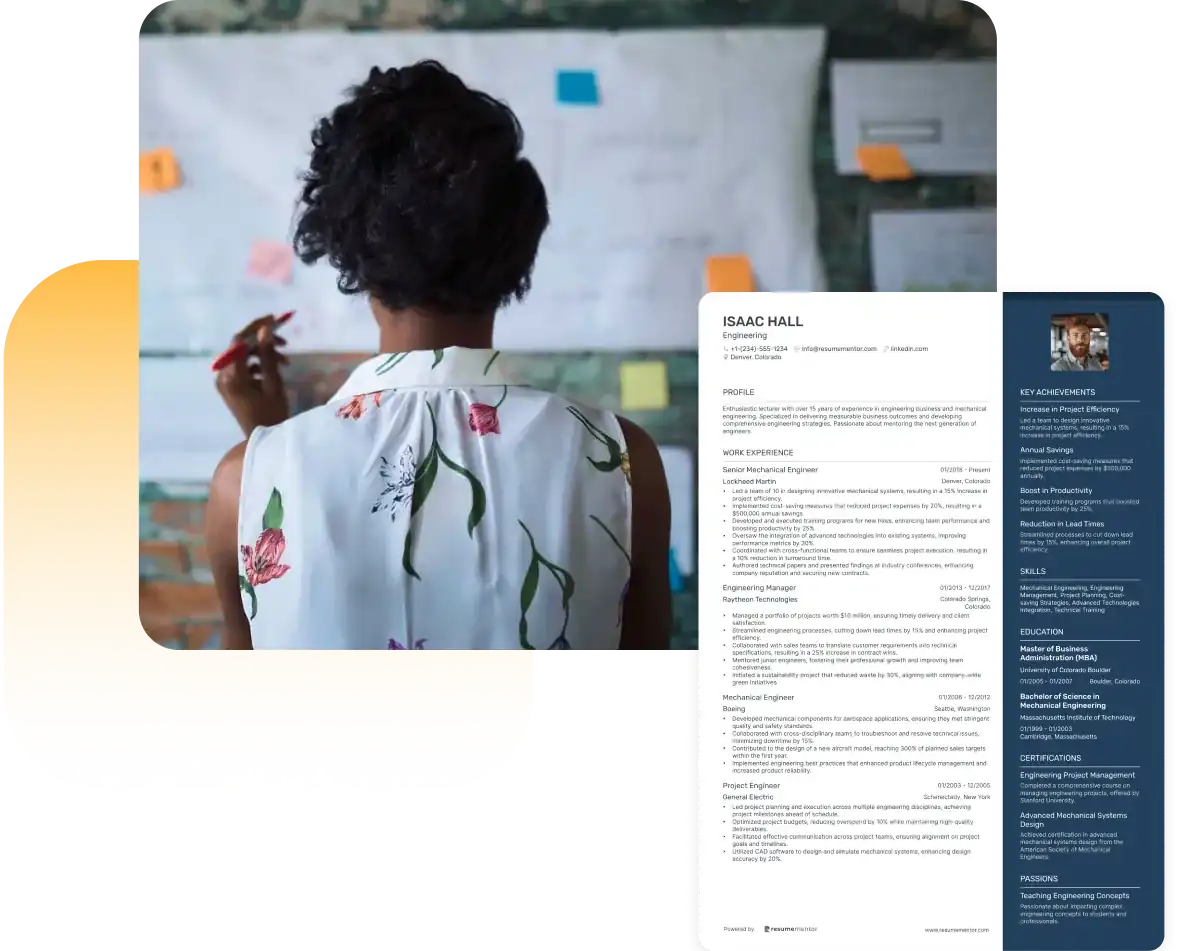
Continue Reading
Check more recommended readings to get the job of your dreams.
Resume
Resources
Tools
© 2025. All rights reserved.
Made with love by people who care.

